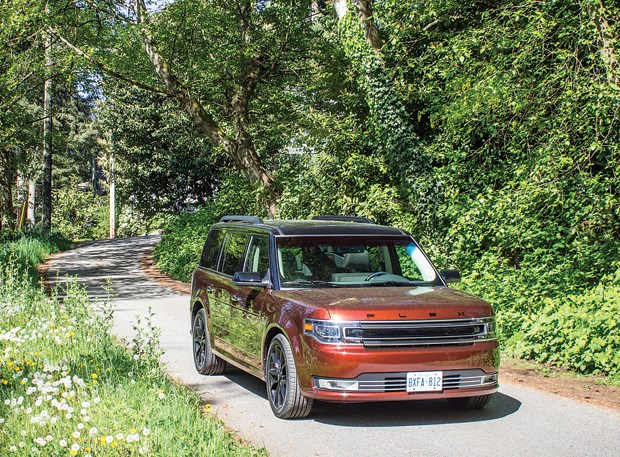Did you ever notice that when you buy your kid something expensive, they’d rather just play with the box it came in?
Boxes are fun not because they lack imagination, but because they require it. A box can be anything. It’s the most efficient use of space, and it can carry more than just stuff.
This is the Ford Flex, the Blue Oval’s big-box solution to family life. (I half wish it would switch names with the Edge, as it’s much edgier. Or, at least, square-er.) It’s a blend of wagon and minivan and crossover, and it doesn’t sell particularly well. So far this year, Ford has sold 10 times as many Edges as it has Flexes. Flexii. Flexuses. Whatever.
And that’s a great shame because the Flex is one of the few honest-feeling machines left on the road. Yes, it’s a box, but that’s the charm of it. It has a lot of space for your things, it stands out in a world of swoopy overstyling, and then there’s its one party trick. What’s in the box? Here you go.
Design
While it would be tempting to simply write “Not Applicable” here and move on, the Flex actually has quite a lot going on in the details. The retro-modern design has a few rounded edges up front, and the facelifted-for-2013 front end still looks fresh. By writing Flex across the nose in huge, broad letters, Ford gives their three-rower a tiny taste of Range Rover. The side strakes give it a bit of a surf wagon vibe. The two tone treatment for the roof is the kind of thing a California Kustom might get. The 20-inch alloys bring the big-rim bling.
All in all, there are nods here to hot rod station wagons of the past, packaged up in a modern all-wheel-drive machine. However, for most people the Flex’s styling will be something to get past. But once you do....
Environment
First box checked: loads of space. Big, wide, and comfy, the first two rows of the Flex’s seating are great for passengers. Rear seat passengers especially will have plenty of room to stretch out, and this top-of-the-line Limited version even has a sunroof for each of the middle-seat passengers.
Third row passengers? Well, which of your kids is the least favourite? Actually, that’s the question you might ask in most three-row crossovers, but the Flex is actually pretty good in this regard. The seats have a little less padding than the front two rows, but there’s plenty of room. Cargo space behind the rear seats is also very good.
For passengers up front, the Flex is looking a little dated. Fit and finish have improved over previous models, and there’s good use of soft-touch materials to make things feel a little more upscale. The big change, however, is the addition of Ford’s new Sync 3 system, which is miles better than the old versions. It’s quicker, sharper, and simpler.
Performance
Given that the Flex looks a bit like a tipped-over refrigerator on wheels, you might be forgiven for thinking it was dead slow. If it’s a refrigerator, however, it’s William “The Refrigerator” Perry. Perry, an all-star defensive lineman, was enormous, but he could run the 100-metre dash in less than twelve seconds.
Likewise, the Ford Flex surprises the critics, especially when equipped with the 365 horsepower twin-turbo Ecoboost engine. Pumping out 350 foot-pounds of torque from 3.5 litres of displacement and mated to a six-speed automatic transmission and all-wheel-drive, the Flex can run to 100 kilometres per hour in less than six seconds.
It’s a completely ridiculous performance, the kind of numbers you’d expect from a Focus ST, not a giant retro-wagon. It’s the king of the onramp.
When the road gets curvy, however, the Flex proves less flexible. Steering feel is negligible, and while Ford employs its torque-vectoring tech to help control understeer, the Flex isn’t a cornering machine. On long highway sweepers, it’s nicely composed, especially as its lower ride height gives less body roll than taller crossovers.
Better to think of the Flex as once again a bit of old school, with great straight-line performance and the perfect setup for driving the whole family to the Grand Canyon. It’s big, fast, and capacious, just like American cars all used to be.
Features
The styling is big box, but the Flex’s price is relatively big ticket. Base models start with a 3.5-litre V-6, cloth seats, a backup camera, and not too much else. The top-spec Limited comes with a huge feature list – including automatic cruise control and power-folding seats – but is priced in the mid-$50K range after all the options are added in. Ouch.
Official fuel economy figures for the twin-turbo 3.5-litre are 10.7 (litres/100 kilometres) on the highway and 14.7 city. The twin-turbo V-6 is most emphatically more Boost than Eco, and consistently got city mileage ratings even with mixed use. However, that’s because it was fun to Flex the throttle.
Green light
Surprisingly quick; lots of interior space; polarizing exterior styling; many unique interior features.
Stop sign
Sub-par fuel economy; polarizing styling; wind noise at highway speeds; high pricetag when fully loaded.
The checkered flag
A unique, characterful take on the family crossover. Neither cheap to buy nor to operate, but never boring.
Competition
Honda Pilot ($35,590): The Pilot used to be a box. Actually, it used to look a bit like a tank. People mostly liked this, but sales declined; just like the Flex, boxy isn’t the safe choice any more.
The new Pilot is much lighter on its feet, and also posts up some excellent fuel economy numbers. It looks just like a big CR-V (and is thus not very exciting), but it’s a very practical choice for the modern Canadian family.
Brendan McAleer is a freelance writer and automotive enthusiast. Contact him at [email protected]. Follow Brendan on Twitter: @brendan_mcaleer.



